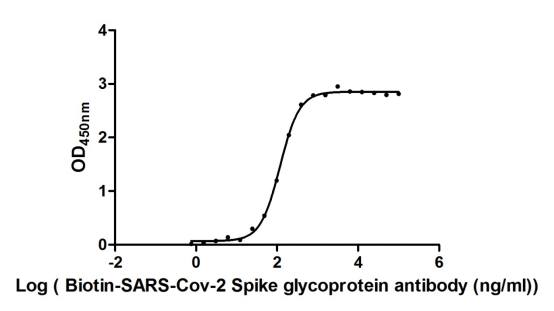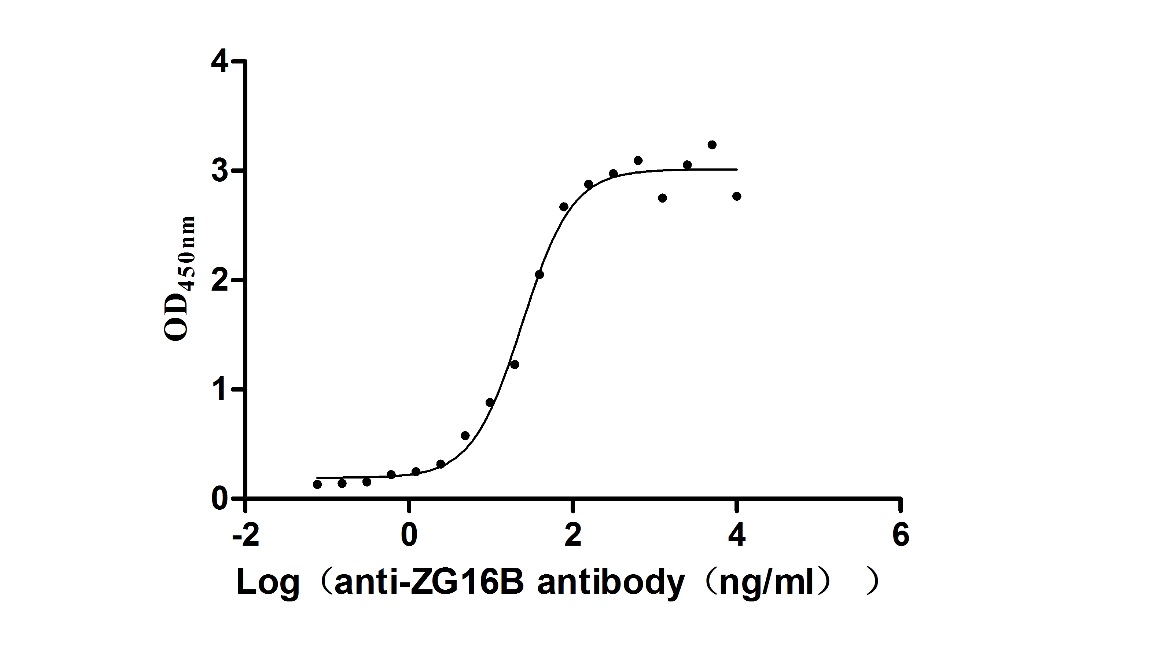Recombinant Human Cyclic nucleotide-gated cation channel beta-3 (CNGB3), partial
-
中文名称:Recombinant Human Cyclic nucleotide-gated cation channel beta-3(CNGB3) ,partial
-
货号:CSB-YP885696HU
-
规格:
-
来源:Yeast
-
其他:
-
中文名称:Recombinant Human Cyclic nucleotide-gated cation channel beta-3(CNGB3) ,partial
-
货号:CSB-EP885696HU
-
规格:
-
来源:E.coli
-
其他:
-
中文名称:Recombinant Human Cyclic nucleotide-gated cation channel beta-3(CNGB3) ,partial
-
货号:CSB-EP885696HU-B
-
规格:
-
来源:E.coli
-
共轭:Avi-tag Biotinylated
E. coli biotin ligase (BirA) is highly specific in covalently attaching biotin to the 15 amino acid AviTag peptide. This recombinant protein was biotinylated in vivo by AviTag-BirA technology, which method is BriA catalyzes amide linkage between the biotin and the specific lysine of the AviTag.
-
其他:
-
中文名称:Recombinant Human Cyclic nucleotide-gated cation channel beta-3(CNGB3) ,partial
-
货号:CSB-BP885696HU
-
规格:
-
来源:Baculovirus
-
其他:
-
中文名称:Recombinant Human Cyclic nucleotide-gated cation channel beta-3(CNGB3) ,partial
-
货号:CSB-MP885696HU
-
规格:
-
来源:Mammalian cell
-
其他:
产品详情
-
纯度:>85% (SDS-PAGE)
-
基因名:
-
Uniprot No.:
-
别名:ACHM1; ACHM3; Achromatopsia (rod monochromacy) 3; CNG channel beta-3; CNGB3; CNGB3_HUMAN; Cone photoreceptor cGMP-gated cation channel beta-subunit; Cone photoreceptor cGMP-gated channel subunit beta; Cyclic nucleotide gated channel beta 3; Cyclic nucleotide-gated cation channel beta-3; Cyclic nucleotide-gated cation channel modulatory subunit; Cyclic nucleotide-gated channel beta-3; RMCH; RMCH1
-
种属:Homo sapiens (Human)
-
蛋白长度:Partial
-
蛋白标签:Tag type will be determined during the manufacturing process.
The tag type will be determined during production process. If you have specified tag type, please tell us and we will develop the specified tag preferentially. -
产品提供形式:Lyophilized powder
Note: We will preferentially ship the format that we have in stock, however, if you have any special requirement for the format, please remark your requirement when placing the order, we will prepare according to your demand. -
复溶:We recommend that this vial be briefly centrifuged prior to opening to bring the contents to the bottom. Please reconstitute protein in deionized sterile water to a concentration of 0.1-1.0 mg/mL.We recommend to add 5-50% of glycerol (final concentration) and aliquot for long-term storage at -20℃/-80℃. Our default final concentration of glycerol is 50%. Customers could use it as reference.
-
储存条件:Store at -20°C/-80°C upon receipt, aliquoting is necessary for mutiple use. Avoid repeated freeze-thaw cycles.
-
保质期:The shelf life is related to many factors, storage state, buffer ingredients, storage temperature and the stability of the protein itself.
Generally, the shelf life of liquid form is 6 months at -20°C/-80°C. The shelf life of lyophilized form is 12 months at -20°C/-80°C. -
货期:Delivery time may differ from different purchasing way or location, please kindly consult your local distributors for specific delivery time.Note: All of our proteins are default shipped with normal blue ice packs, if you request to ship with dry ice, please communicate with us in advance and extra fees will be charged.
-
注意事项:Repeated freezing and thawing is not recommended. Store working aliquots at 4°C for up to one week.
-
Datasheet :Please contact us to get it.
靶点详情
-
功能:Visual signal transduction is mediated by a G-protein coupled cascade using cGMP as second messenger. This protein can be activated by cGMP which leads to an opening of the cation channel and thereby causing a depolarization of rod photoreceptors. Induced a flickering channel gating, weakened the outward rectification in the presence of extracellular calcium, increased sensitivity for L-cis diltiazem and enhanced the cAMP efficiency of the channel when coexpressed with CNGA3. Essential for the generation of light-evoked electrical responses in t...显示更多
-
基因功能参考文献:
- The results of this study do not support the hypothesis that the focal chorioretinitis seen with high doses of AAV5-PR2.1-hCNGB3 in the initial studies was due to an immune response to human CNGB3. PMID: 29020838
- a comprehensive view on the spectrum and prevalence of CNGB3 mutations in achromatopsia patients. PMID: 28795510
- Although the defect that causes achromatopsia is primarily in the cone photoreceptors, our results reveal an accompanying disruption of rod function that is more severe than has previously been reported. The differential effects on the b-wave relative to the a-wave points to an inner-retinal locus for the disruption of rod function in these patients. PMID: 28929832
- Foveal cone structure showed little or no change in this group of subjects with CNGB3-associated achromatopsia. Over the time scales investigated (6-26 months), achromatopsia seems to be a structurally stable condition, although longer-term follow-up is needed. PMID: 28145975
- The degree of residual foveal cone structure varies greatly among subjects with CNGB3-associated ACHM. PMID: 27479814
- Eight different mutations were detected in the CNGB3 gene in achromatopsia, including five novel mutations: two splice site mutations, one nonsense substitution, and two frame-shift mutations. PMID: 25558176
- Genetic testing revealed a common homozygous mutation in CNGB3 in 5 patients with complete achromatopsia and heterozygous mutations in CNGA3 in 2 patients with incomplete achromatopsia. PMID: 24676353
- Genetic testing performed at Carver lab at the University of Iowa confirmed a diagnosis of achromatopsia with identical mutations in the CNGB3 gene. PMID: 24664743
- The majority (n = 12) of patients were either homozygotes or compound heterozygotes for known achromatopsia alleles, two in CNGB3 (p.T383fsX and p.T296YfsX9) and three in CNGA3 (p.R283Q, p.R427C and p.L527R). PMID: 23362848
- Data found pathogenic DNA variants in the genes RP1, USH2A, CNGB3, NMNAT1, CHM, and ABCA4, responsible for retinitis pigmentosa, Usher syndrome, achromatopsia, Leber congenital amaurosis, choroideremia, or recessive Stargardt/cone-rod dystrophy cases. PMID: 23940504
- Achromatopsia associated F525N and T383fsX mutations in the CNGB3 subunit of cone photoreceptor cyclic nucleotide-gated (CNG) channels increases susceptibility to cell death in photoreceptor-derived cells. PMID: 23805033
- Missense mutations, nonsense mutations, splice mutations, and small deletions and insertions in the affected genes cause achromatopsia. PMID: 21267001
- Subretinal administration of rAAV5-hCNGB3 with a long version of the red cone opsin promoter in younger animals led to a stable therapeutic effect for at least 33 months. PMID: 20378608
- Genetic analysis of two Pakistani families with retinal disease enabled the establishment of the correct diagnosis of achromatopsia. Two novel mutations were identified in CNGA3 and CNGB3 that are both specifically expressed in cone photoreceptors. PMID: 20454696
- Our data indicate that these genes are involved in a broader spectrum of cone dysfunction, and it remains intriguing why initial cone function can be spared despite similar gene defects. PMID: 20079539
- down-regulation of CNGA3 contributes to the pathogenic mechanism by which CNGB3 mutations lead to human cone disease. PMID: 19767295
- NH2- and COOH-terminal calmodulin-binding sites in CNGB3 are functionally important for regulation of cyclic nucleotide-gated channel activity PMID: 12730238
- CNGB3 has a role in determining ligand sensitivity and pore properties of heteromeric channels PMID: 12815043
- Novel causative CNGB3 missense mutations found in Achromatopsia patients in the United Kingdom. PMID: 14757870
- Cone photoreceptor cyclic nucleotide-gated channels are tetrameric assemblies of CNGB3 (B3) subunits. The stoichiometry and arrangement for B3 show pore-forming tetramers and like subunits are positioned adjacent to each other. PMID: 15134637
- In this study, a novel Arg403Gln mutation was identified, located in the middle of the pore domain of the cone CNG cation channel beta-subunit, which when associated with the nonsense mutation Thr383fs, resulted in progressive cone dystrophy. PMID: 15161866
- findings indicate that the CNGB3/ACHM3 locus on chromosome 8q21 is the major locus for achromatopsia in patients of European origin or descent PMID: 15657609
- Out of 36 achromats, 12 (33%) had mutations in CNGB3 (six different mutations including four novel mutations). CNGB3 should be considered as a candidate gene to be evaluated in patients with forms of cone dysfunction, including macular degeneration. PMID: 15712225
- Mutations in CNGA3 and CNGB3 account for achromatopsia in Hungarian patients including known mutations and a few new CNGB3 mutations. PMID: 16319819
- We have examined the gating effects of two previously uncharacterized disease-associated mutations in the CNGB3 subunit and found that in each case, the mutations resulted in a gain of function molecular phenotype. PMID: 16379026
- Phospholipid metabolism and exogenously applied phosphatidylinositol 3,4,5-trisphosphate can modulate heterologously expressed cone CNG channels. PMID: 17018579
- CNGA3 and CNGB3 mutations are responsible for the substantial majority of achromatopsia. Furthermore, the CNGB3 mutation p.T383fsX is a predominant mutation, results from a founder effect PMID: 17265047
- Testing confirms the diagnosis at the molecular level and allows for a more precise prognosis of the possible future clinical evolution PMID: 17651254
- Foveomacular atrophy can occur in CNGB3-affected subjects, and even heterozygous carriers can exhibit maculopathy PMID: 17652762
- The CNGB3 gene was by far the most important causal gene, and T383IfsX13 the most frequent mutation in complete and incomplete achromatopsia. PMID: 19592100
收起更多
-
相关疾病:Stargardt disease 1 (STGD1); Achromatopsia 3 (ACHM3)
-
亚细胞定位:Membrane; Multi-pass membrane protein.
-
蛋白家族:Cyclic nucleotide-gated cation channel (TC 1.A.1.5) family, CNGB3 subfamily
-
组织特异性:Expressed specifically in the retina.
-
数据库链接:






-AC1.jpg)












